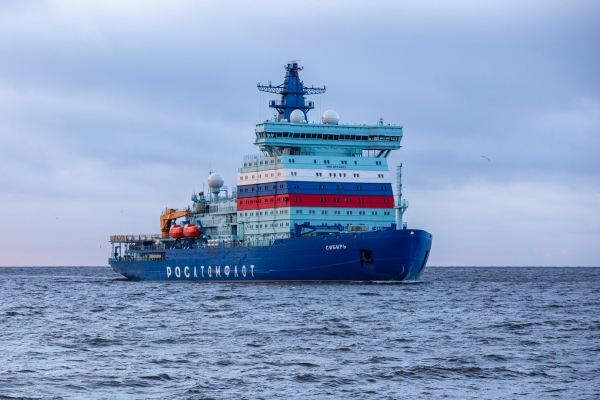
Nuclear-powered icebreaker Sibir, the first serial icebreaker of Project 22220, has left Saint-Petersburg for Murmansk today, 13 January 2022, says FSUE Atomflot.
The transition is to take 8-9 days.
According to Leonid Irlitsa, Deputy General Director, Shipping Director of FSUE Atomflot, “the serial nuclear-powered icebreaker Sibir is manned with skilled navigators who have worked thoroughly on the route and are well aware it”.
Weather conditions in the North Sea and in the Norwegian Sea are not favorable today with wind gusting to 30 m per sec. The Marine Operations Headquarter will provide the captain with recommendations for a safe passage of the route.
Testing and monitoring of all ship systems will continue in the coming months.
In several days after arrival in the port of Murmansk, nuclear-powered icebreaker Sibir is to leave for its first operational voyage. The ship will operate in the western sector of the Arctic – Ob-Yenisey area of the Kara Sea.
The Sibir is the second ship of Project 22220 built by Baltiysky Zavod shipyard. Laid down on 26 May 2015, it was launched on 22 September 2017.
Multipurpose nuclear-powered icebreakers of Project 22220 ships are the world’s largest and most powerful icebreaking ships. Their key task is to ensure year-round navigation in the western Arctic. Icebreakers of 22220 design will form the basis of Russia’s civil icebreaking fleet in the near time.
Key particulars of Project 22220: capacity - 60 MW, operational speed - 22 knots (clean water), LOA - 173.3 m (160 m, DWL), beam - 34 m (33 m, DWL), height - 52 m; draft (DWL) - 10.5 m; minimum draft - 8.65 m, maximum icebreaking capability - 2.8-meter-thick ice (at full capacity and speed of 1.5-2 knots); full displacement – 33,540 tonnes; designated service life - 40 years, crew - 53.
The icebreaker will be powered by a pair RITM-200 reactors of 175 MW. The new generation system was developed specially for this ship. The vessels dual-draft concept and capability will allow operating them both in the Arctic and in the mouths of the polar rivers.
The icebreakers designed by naval architecture and marine engineering firm CDB Iceberg in 2009 will be operated in the western region of the Arctic: in the Barents, Pechora and Kara Seas, as well as in shallower areas of the Yenisei estuary and the Ob Bay area.
Under the contract with FSUE Rosatomflot, Baltiysky Zavod shipyard is building a series of five nuclear-powered icebreakers of Project 22220. The lead icebreaker named Arktika was put into operation in 2020, The Sibir, Ural, Yakutia and Chukotka icebreakers are under construction. The series can be extended to 7 icebreakers.
Related links:
Baltiysky Zavod shipyard delivers Sibir, first serial icebreaker of Project 22220, to Atomflot>>>>
First serial icebreaker of Project 22220, Sibir, completed final phase of shipbuilder’s sea trials >>>>
Nuclear-powered icebreaker Sibir to commence operation in Kara Sea in early January 2022 – Vyacheslav Ruksha >>>>
Icebreaker Sibir of Project 22220 completed main part of shipbuilder’s sea trials>>>>
Rosatom expects nuclear-powered icebreaker Sibir to commence operation in 2022>>>>
Baltiysky Zavod sends nuclear-powered icebreaker Sibir for sea trials >>>>



